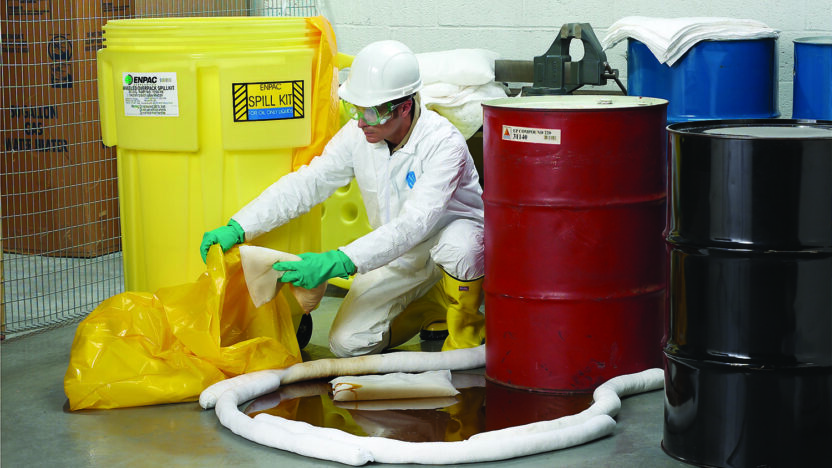Oil Spill Kits:
When it comes to workplace safety and environmental protection, Oil Spill Kits are one of the most essential tools in any industrial, marine, or transport setting. Whether you’re working at a construction site, a fuel depot, a factory, or even a logistics warehouse, oil spills are not just messy—they’re dangerous, costly, and potentially illegal if not managed quickly.
What Is an Oil Spill Kit?
An Oil Spill Kit is a specially assembled collection of absorbent materials and tools designed to contain, absorb, and clean up oil-based liquids in the event of a leak or spill. These kits are typically used in environments where fuel, lubricants, hydraulic oil, and other petroleum-based substances are handled regularly.
Unlike general spill kits, oil spill kits are hydrophobic, meaning they repel water and are designed specifically to soak up oil while leaving water behind. This makes them ideal for outdoor spills or situations involving waterways.
Key Components of an Oil Spill Kit
Absorbent Socks & Booms:
Ideal for creating containment barriers and stopping the spread of a spill.
Disposal Bags & Ties:
To ensure the safe disposal of used absorbents and contaminated materials.
Instruction Manual:
Step-by-step guidance for effective spill management.
Drip Trays or Drain Covers:
Prevent oils from entering drainage systems or open water.
Why Are Oil Spill Kits So Important?
Environmental Protection
Oil spills can contaminate soil, water, and air, creating long-term damage to ecosystems. In the UK, releasing oil into waterways or soil without prompt cleanup can result in heavy fines under the Environmental Protection Act 1990. Oil spill kits offer a fast and effective means of preventing contamination.
Health & Safety
Oil is a slip hazard and poses health risks through skin contact or inhalation. A quick response using a spill kit can prevent accidents and reduce exposure for employees and the public.
Compliance with Regulations
UK businesses must comply with the Control of Substances Hazardous to Health (COSHH) and Environmental Agency guidelines. Having a spill kit on-site demonstrates preparedness and reduces liability in the event of an incident.
Business Continuity
Spills that aren’t managed promptly can halt operations, damage equipment, and result in costly cleanups. A spill kit ensures minimal disruption and keeps the process moving smoothly.
Where Should Oil Spill Kits Be Used?
- Vehicle maintenance bays
- Fuel stations or depots
- Marine docks and harbours
- Warehouses with machinery
- Construction and civil engineering sites
- Manufacturing plants
- Farms and agricultural operations
Position kits in easily accessible, high-risk areas and ensure staff are properly trained to use them correctly.

Customising Your Oil Spill Kit
Not all kits are created equal. While pre-packed kits are suitable for most applications, some industries require custom spill kits tailored to their operations. For example:
- Marine operations may need floating booms and waterproof disposal bags.
- Remote sites benefit from mobile kits with wheeled containers for portability.
- Laboratories might require compact kits with chemical resistance for oil-based reagents.
Consulting with a spill response specialist can help identify the right type and quantity of absorbents for your specific environment.
Maintenance and Training
Owning a spill kit is not enough. Regular checks should be performed to ensure the kit is stocked, intact, and accessible. Items like gloves and bags may degrade over time, so keep expiry dates in check.
Moreover, staff training is essential. Employees should know:
- Where the kits are stored
- How to safely use the components
- Proper disposal procedures for used materials
What Are Spill Kits and What Do Companies Recommend When Choosing One?
Spill kits are crucial safety tools designed for the rapid containment and cleanup of hazardous spills, including oil, chemicals, and other liquids. These kits typically contain essential items such as absorbent pads, absorbent socks, protective gloves, and disposal bags, all aimed at ensuring a swift and effective response to minimise risks and maintain a safe environment.
Leading safety companies recommend selecting a spill kit based on the type of liquid being handled—oil-only kits for hydrocarbons, chemical kits for corrosive substances, and universal kits for general-purpose spills. Brands like 3M, Brady, and Ecospill advise businesses to assess spill volume risks, storage locations, and accessibility to ensure the kit is suitable for its intended purpose. Regular maintenance and staff training are also highly recommended.
Final Thoughts:
An oil spill kit might seem like a minor safety measure until the moment you need it, then it becomes invaluable. Whether you’re managing a busy depot or a small agricultural site, preparedness is your best insurance policy. Investing in high-quality oil spill kits, ensuring proper placement, and training your team can save you thousands in cleanup costs, regulatory fines, and reputational damage.
In a world increasingly focused on sustainability and responsibility, having the right spill response system in place isn’t just smart—it’s essential.



